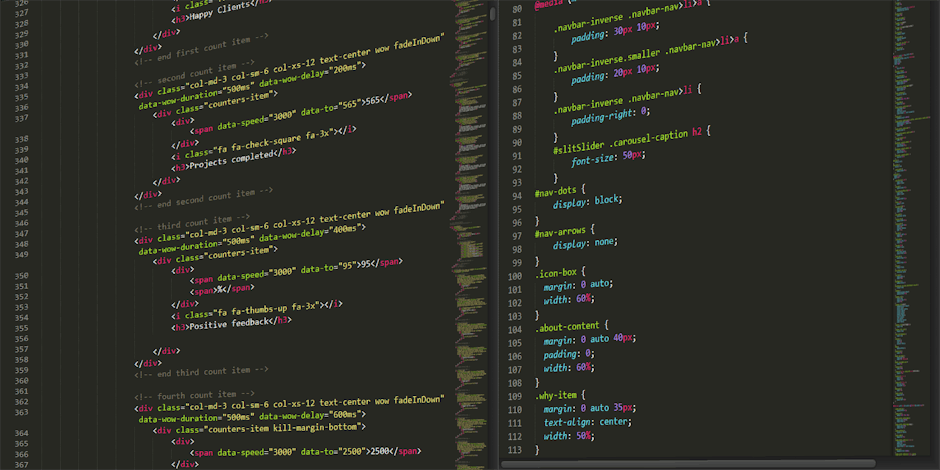 html
html
E-commerce scraping how-to a simple guide explained
What is E-commerce Web Scraping?
Let's break down e-commerce web scraping. Imagine you want to keep an eye on the prices of your favorite gadgets on Amazon, or track when a specific out-of-stock item becomes available again. Doing this manually, constantly checking websites, is time-consuming and, frankly, boring. That's where web scraping comes in. In essence, data scraping automates this process. It’s like having a robot that visits websites for you, extracts the specific data you need (prices, product descriptions, availability), and neatly organizes it for you to analyze.
E-commerce data scraping services allow us to automatically extract data from e-commerce websites. This data can be used for a variety of purposes, including:
- Price tracking: Monitor competitor prices to stay competitive.
- Product details: Gather product descriptions, images, and specifications for competitive analysis or populating your own database.
- Availability monitoring: Track stock levels and receive alerts when products become available or unavailable.
- Catalog clean-ups: Identify and correct errors or inconsistencies in product catalogs.
- Deal alerts: Get notified about special offers, discounts, and promotions.
Think of it this way: Instead of manually copying and pasting information from multiple web pages into a spreadsheet, a web scraping tool does it all for you, quickly and efficiently.
Why is E-commerce Scraping Useful?
The power of e-commerce scraping lies in its ability to unlock valuable information that can drive data-driven decision making. Here are some key benefits:
- Competitive Intelligence: Keep a close eye on your competitors' pricing strategies, product offerings, and marketing tactics. This competitive intelligence allows you to adjust your own strategy to stay ahead of the game.
- Market Research: Understand market trends, identify popular products, and analyze customer behaviour.
- Price Optimization: Adjust your prices dynamically based on competitor pricing and market demand to maximize profit.
- Inventory Management: Optimize your inventory management by tracking stock levels and predicting demand based on historical data.
- Lead Generation: Identify potential customers and gather contact information.
- Trend Spotting: Identify emerging trends and popular products that can guide your product development or marketing strategies. Scraping can even be used for news scraping to identify overall market trends.
In short, e-commerce scraping provides the raw data you need to make informed decisions and gain a competitive advantage in the online marketplace. The insights gleaned from data analysis of scraped data can be invaluable.
A Simple Step-by-Step Guide to E-commerce Scraping (Simplified Example)
Let's walk through a very simplified example to illustrate the basic principles of web scraping. We'll use Python and a library called `requests` to fetch the HTML content of a webpage and then use `Beautiful Soup` to parse the HTML and extract the data we need. This is a simplified example. More robust solutions, particularly for complex e-commerce sites, might benefit from tools such as Scrapy.
Disclaimer: This is a simplified example and might not work directly on all websites due to variations in HTML structure and anti-scraping measures. Always respect the website's terms of service and robots.txt file (more on that later).
Step 1: Install the Required Libraries
First, you'll need to install the `requests` and `Beautiful Soup` libraries. You can do this using pip:
pip install requests beautifulsoup4Step 2: Import the Libraries
In your Python script, import the libraries:
import requests
from bs4 import BeautifulSoupStep 3: Fetch the Webpage Content
Use the `requests` library to fetch the HTML content of the webpage you want to scrape. Let's say we want to scrape the title of a product page on a (fictional) website:
url = "https://www.example-ecommerce-site.com/product/123"
response = requests.get(url)
# Check if the request was successful (status code 200)
if response.status_code == 200:
html_content = response.content
else:
print(f"Error: Could not fetch page. Status code: {response.status_code}")
exit()Step 4: Parse the HTML Content
Use `Beautiful Soup` to parse the HTML content:
soup = BeautifulSoup(html_content, 'html.parser')Step 5: Extract the Data
Now, use `Beautiful Soup`'s methods to find the specific HTML elements containing the data you want to extract. Let's say the product title is within an `
` tag with the class "product-title":
product_title = soup.find('h1', class_='product-title').text.strip()
print(f"Product Title: {product_title}")
product_title = soup.find('h1', class_='product-title').text.strip()
print(f"Product Title: {product_title}")Step 6: Run the Code
Run your Python script. You should see the product title printed in the console.
Explanation:
- `requests.get(url)`: Sends an HTTP request to the specified URL and retrieves the HTML content.
- `BeautifulSoup(html_content, 'html.parser')`: Creates a BeautifulSoup object, parsing the HTML content into a navigable tree structure.
- `soup.find('h1', class_='product-title')`: Finds the first `
` tag with the class "product-title".
- `.text`: Extracts the text content of the HTML element.
- `.strip()`: Removes any leading or trailing whitespace.
This is a very basic example. Real-world e-commerce websites often have much more complex HTML structures and employ anti-scraping techniques. Libraries like Scrapy are designed to handle more complex scenarios.
Handling Pagination and Dynamic Content
Many e-commerce sites display products across multiple pages (pagination). You'll need to handle pagination to scrape all the products. This often involves identifying the URL pattern for subsequent pages (e.g., `?page=2`, `&p=2`) and iterating through these URLs. Similarly, some websites load content dynamically using JavaScript. In such cases, tools like Selenium or Puppeteer are needed to render the JavaScript and then scrape the generated HTML. These are headless browsers that you can control with Python.
Using PyArrow for Efficient Data Handling
Once you've scraped the data, you'll need to store and process it. PyArrow provides a powerful and efficient way to handle large datasets in memory. Here's a Python snippet demonstrating how to store scraped data into a PyArrow table:
import pyarrow as pa
import pyarrow.parquet as pq
# Sample scraped data (replace with your actual data)
product_names = ["Product A", "Product B", "Product C"]
prices = [10.99, 20.50, 15.75]
availability = [True, False, True]
# Create PyArrow arrays
product_names_array = pa.array(product_names)
prices_array = pa.array(prices)
availability_array = pa.array(availability)
# Create a PyArrow table
table = pa.Table.from_arrays([product_names_array, prices_array, availability_array],
names=["product_name", "price", "availability"])
# Print the table schema
print(table.schema)
# Write the table to a Parquet file (efficient columnar storage)
pq.write_table(table, 'scraped_data.parquet')
print("Data written to scraped_data.parquet")
# Example of reading the Parquet file back
table2 = pq.read_table('scraped_data.parquet')
print(table2)
This snippet:
- Imports the `pyarrow` and `pyarrow.parquet` libraries.
- Creates PyArrow arrays from the scraped data (product names, prices, and availability).
- Creates a PyArrow table from the arrays, assigning names to each column.
- Writes the table to a Parquet file, a columnar storage format that's highly efficient for analytical queries.
- Reads the data back from the Parquet file.
PyArrow allows for efficient data manipulation and integration with other data processing tools like Pandas and Spark. It's especially useful when dealing with big data scraped from e-commerce websites.
Ethical and Legal Considerations: Is Web Scraping Legal?
Web scraping is legal in many cases, but it's crucial to be aware of the ethical and legal boundaries. Always respect the website's terms of service (ToS) and robots.txt file. The robots.txt file is a text file that websites use to instruct web robots (including web scrapers) about which parts of the site they are allowed to crawl and which they are not. You can usually find it at `www.example.com/robots.txt`.
Here are some key considerations:
- Read the robots.txt file: Always check the robots.txt file to see if the website prohibits scraping.
- Respect the terms of service: Review the website's terms of service to ensure that scraping is not prohibited.
- Avoid overloading the server: Scrape responsibly by implementing delays between requests to avoid overwhelming the website's server. Don't make requests too quickly.
- Do not scrape personal data without consent: Avoid scraping personal data (e.g., email addresses, phone numbers) without explicit consent. This is especially important in light of regulations like GDPR and CCPA. This is crucial.
- Attribute the source: If you use the scraped data, give credit to the original source.
Ignoring these guidelines can lead to your IP address being blocked, legal action, or damage to your reputation. Web scraping, Twitter data scraper, or any other form of scraping must be done ethically.
Beyond the Basics: Advanced Scraping Techniques
Once you've mastered the basics, you can explore more advanced scraping techniques:
- API Scraping: Some websites provide APIs (Application Programming Interfaces) that allow you to access data in a structured format. Using APIs is often a more efficient and reliable way to retrieve data than scraping HTML. While not strictly "scraping", API scraping provides data access, often governed by rate limits.
- Using Proxies: Rotating proxies can help you avoid being blocked by websites that implement anti-scraping measures.
- Headless Browsers: Tools like Selenium and Puppeteer allow you to control a headless browser (a browser without a graphical user interface) to render JavaScript and scrape dynamic content.
- CAPTCHA Solving: Some websites use CAPTCHAs to prevent bots from scraping data. You can use CAPTCHA solving services to automate the process of solving CAPTCHAs.
- Sentiment Analysis: After scraping product reviews, you can perform sentiment analysis to understand customer opinions and identify areas for improvement.
For those looking for robust and scalable solutions, consider a professional web scraping service.
Real-Time Analytics and E-commerce Scraping
Combining e-commerce scraping with real-time analytics allows businesses to gain immediate insights into market dynamics and customer behavior. For example, a retailer can track competitor prices in real-time and dynamically adjust their own prices to maintain a competitive edge. Similarly, news scraping combined with real-time analysis can help identify emerging trends and consumer preferences.
Furthermore, by integrating scraped data with sentiment analysis tools, businesses can monitor customer reviews and social media mentions to gauge brand perception and identify potential issues. This proactive approach enables them to respond quickly to negative feedback and improve customer satisfaction.
Checklist to Get Started with E-commerce Scraping
Ready to dive in? Here's a quick checklist to help you get started:
- Define your goals: What data do you need, and what will you use it for?
- Choose your tools: Select the appropriate libraries or tools (e.g., Python, requests, Beautiful Soup, Scrapy).
- Identify your target website: Choose the e-commerce website you want to scrape.
- Inspect the HTML structure: Use your browser's developer tools to examine the HTML structure of the webpages you want to scrape.
- Write your scraper: Develop your scraping script to extract the desired data.
- Test your scraper: Run your scraper and verify that it's extracting the correct data.
- Implement error handling: Add error handling to your scraper to gracefully handle unexpected issues.
- Respect robots.txt and ToS: Always adhere to the website's robots.txt file and terms of service.
- Store and process the data: Store the scraped data in a structured format (e.g., CSV, JSON, database) and process it for analysis.
The Power of Data in E-commerce
E-commerce scraping provides a powerful means to gather and analyze data. It can uncover insights that were previously hidden, leading to better decision-making, improved strategies, and a stronger competitive position. This can lead to better inventory management and improved product offerings.
Ready to unlock the power of data for your e-commerce business?
Sign up to start your data-driven journey!
#WebScraping #Ecommerce #DataScraping #DataAnalysis #CompetitiveIntelligence #Python #Scrapy #BigData #PriceTracking #DataDriven

